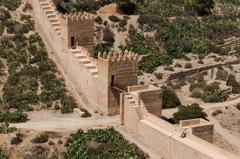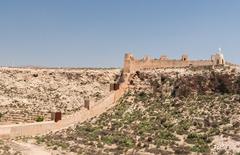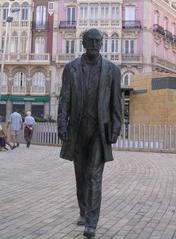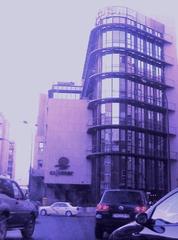
Puerta de la Almudaina: Visiting Hours, Tickets, and Comprehensive Guide to Almería’s Historic Gateway
Date: 14/06/2025
Introduction
The Puerta de la Almudaina stands as a powerful symbol of Almería’s rich, multi-layered history. This gateway, dating from the 10th century, originally marked a main entrance through the fortified city walls during the period of Islamic rule in Al-Andalus. Over the centuries, it has borne witness to the city’s transformation—from a bustling Islamic port to a Christian stronghold—serving as a testament to Almería’s strategic significance in the Mediterranean.
Today, Puerta de la Almudaina is integrated into the urban fabric of Almería and preserved within the Enclave Arqueológico Puerta de Almería, which also showcases Roman industrial heritage. This guide offers a detailed exploration of the site’s historical and architectural importance, practical visitor information, travel tips, and highlights of nearby attractions.
Whether you are a history enthusiast or a traveler seeking authentic cultural experiences, this article provides an in-depth resource for planning your visit to one of Almería’s most treasured landmarks. For the latest updates, consult the Ayuntamiento de Almería, Evendo, and Gulliveria.
Historical Context
Origins and Medieval Importance
The Puerta de la Almudaina is a surviving remnant of Almería’s Islamic period, constructed when the city flourished under the Caliphate of Córdoba. Its name derives from the Arabic “al-mudayna,” meaning “citadel” or “fortified enclosure”—highlighting its role as both a defensive structure and a symbol of autonomy. The gate formed part of the southern section of the city’s fortified walls, controlling access between the port and the medina (Gulliveria).
Role in Defense and Daily Life
Throughout the Middle Ages, city walls and gates like Puerta de la Almudaina played a vital defensive role, especially during periods of conflict such as the Christian Reconquista. The gate regulated the movement of people and goods, functioning as a checkpoint for trade and taxation. Even after the Christian conquest in 1489, the gate retained its significance as a point of entry and urban landmark (whichmuseum.com).
Architectural Features
Construction and Materials
The gateway exemplifies Moorish military design, constructed primarily from local stone and brick. The characteristic horseshoe arch—a hallmark of Islamic architecture—provided both structural strength and aesthetic appeal. The walls, often over a meter thick, were built to withstand sieges and attacks (whichmuseum.com).
Defensive and Symbolic Elements
Originally, the gate would have been flanked by towers for surveillance and defense. Arrow slits and staggered approaches slowed attackers while providing vantage points for defenders. While much of the original decoration has been lost, traces of geometric motifs and inscriptions hint at its former grandeur.
Integration with Urban Layout
Strategically located near the port and the Alcazaba fortress, Puerta de la Almudaina facilitated commerce and administration, connecting key zones of the city. Today, the area retains elements of the old medina’s street patterns, offering visitors a sense of the medieval city’s atmosphere (Gulliveria).
Archaeological and Cultural Significance
Discovery and Preservation
The site is preserved within the Enclave Arqueológico Puerta de Almería, which also includes Roman-era remains such as a fish-salting factory. This enclave provides valuable insights into the city’s layered history and is open to the public with educational displays (whichmuseum.com).
Educational and Community Value
The Puerta de la Almudaina remains a focus for local heritage events, guided tours, and educational programs, fostering a deeper appreciation of Almería’s multicultural legacy (Weeky.es, Spanish Plains).
Visitor Information
Location and Getting There
- Address: Camino Loma San Cristóbal, 113, 04003 Almería, Spain (CastillosNet)
- On Foot: Easily reachable from Almería’s city center—follow signs to the Alcazaba or use the walking routes from central plazas.
- Public Transport: Bus lines 6 and 12, and nearby tram stops, provide convenient access (Evendo).
- Taxi: Readily available from city center stands.
Visiting Hours and Admission
- Hours: The gate is an open-air monument accessible at all times.
- Admission: Free entry; no tickets required. The enclave/museum may have specific hours—check current schedules on official sites.
Accessibility
- The area is mostly flat but features cobbled, sometimes uneven, historic streets. Wheelchair access may be limited; assistance is available at tourist information centers (Evendo).
- No on-site restrooms, but facilities are available nearby.
Tips for Visitors
- Photography: Visit at sunrise or sunset for optimal lighting on the stonework and panoramic city views.
- Combine Visits: Nearby attractions include the Alcazaba fortress, Almería Cathedral, and Museo de Almería (My Little World of Travelling).
- Plan Ahead: Research the site’s history or use a mobile guide app, as on-site signage is limited.
Nearby Attractions
- Alcazaba of Almería: Impressive Moorish fortress with gardens and panoramic views.
- Almería Cathedral: Gothic-Renaissance cathedral with fortress features.
- Museo de Almería: Exhibits spanning from prehistory to Roman times.
- Barrio de La Chanca: Colorful neighborhood with a rich multicultural heritage.
- Local Cafés and Shops: Enjoy Andalusian cuisine and artisan goods within walking distance (Evendo).
Frequently Asked Questions (FAQ)
Q: What are the Puerta de la Almudaina visiting hours?
A: The site is accessible 24/7 for outdoor viewing. Museum/enclave hours may vary; check official sources.
Q: Is there an admission fee?
A: No, entry is free. Guided tours may have a fee.
Q: Is the site accessible for people with mobility challenges?
A: Some nearby streets are uneven, but the immediate area around the gate is relatively flat. Assistance is available from tourist offices.
Q: Are guided tours available?
A: Occasionally, via local tourism providers. Book in advance for availability.
Q: What other sites should I visit nearby?
A: The Alcazaba, Almería Cathedral, and Museo de Almería are all within walking distance.
Practical Visitor Recommendations
- Best Times: Early morning or late afternoon for photography and cooler temperatures.
- What to Bring: Comfortable shoes, water, sun protection.
- Transport: Explore on foot or use local buses for easy access.
- Language: Most signage is in Spanish; tourist offices provide multilingual support.
Visuals and Media
- Include high-resolution images of the gateway’s horseshoe arch (alt text: “Puerta de la Almudaina horseshoe arch in Almería”).
- Embed an interactive map to highlight the gate and nearby attractions.
- Offer virtual tours or photo galleries through official tourism platforms.
Conclusion
The Puerta de la Almudaina is not just a relic of the past but a living symbol of Almería’s enduring spirit and complex history. With free, year-round access and a wealth of nearby historical and cultural attractions, it is a must-see for anyone visiting the city. Enhance your experience by exploring related sites, engaging with guided tours, and using digital resources like the Audiala app for deeper insights. Your visit helps keep Almería’s remarkable heritage alive for future generations.
References and Further Information
- Gulliveria – La Almería Musulmana
- whichmuseum.com – Enclave Arqueológico Puerta de Almería
- Evendo – Puerta de la Almudaina
- Google Arts & Culture – The Historic Citadel
- CastillosNet – Puerta de la Almudaina
- choose-almeria.com – Almería City Guide
- Traveler.es – Barrio de la Almedina



